The Multiculturalism Policy 2017 and Early Year Learning Concept 2022
VerifiedAdded on 2022/09/15
|10
|2773
|21
AI Summary
Contribute Materials
Your contribution can guide someone’s learning journey. Share your
documents today.
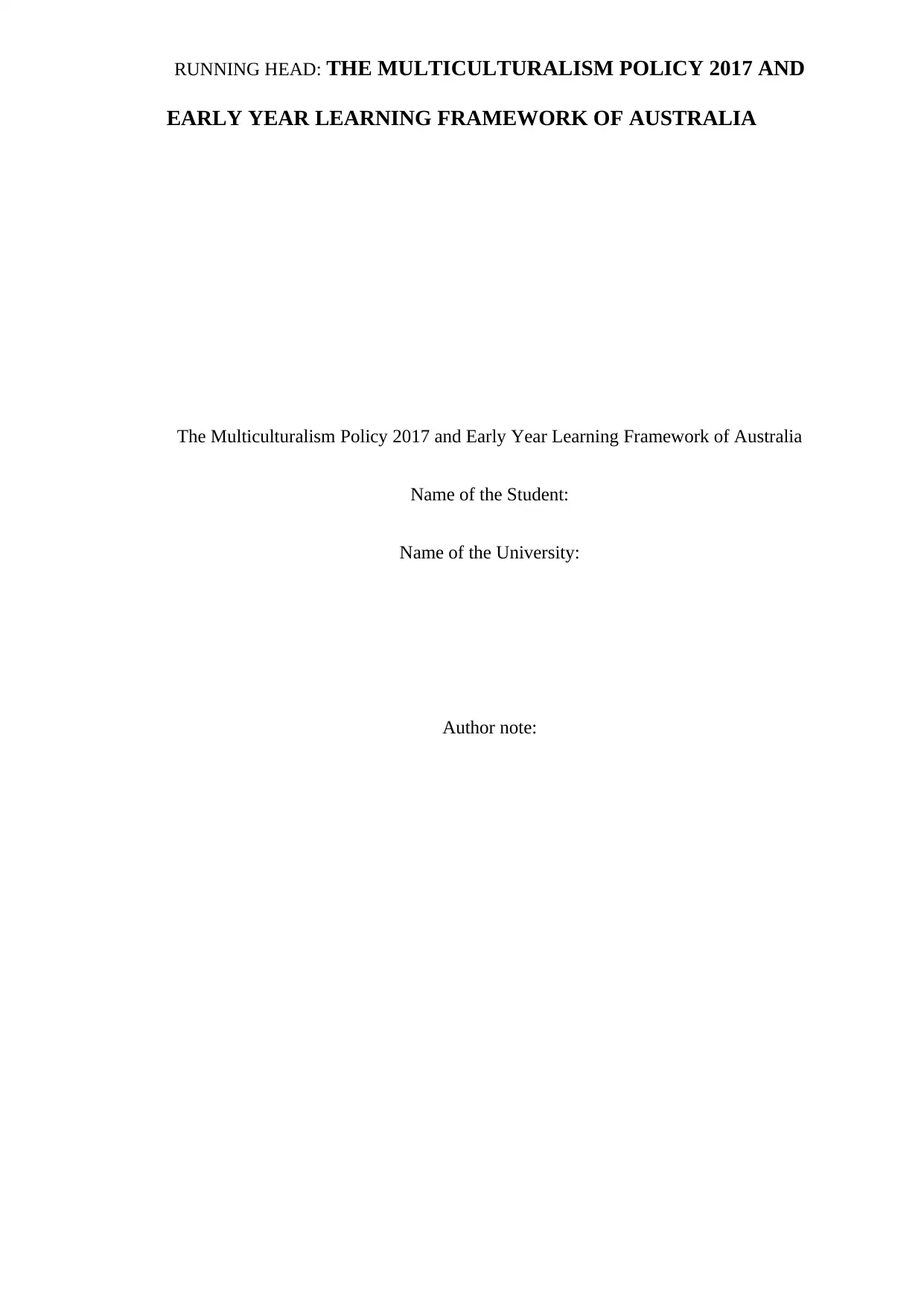
RUNNING HEAD: THE MULTICULTURALISM POLICY 2017 AND
EARLY YEAR LEARNING FRAMEWORK OF AUSTRALIA
The Multiculturalism Policy 2017 and Early Year Learning Framework of Australia
Name of the Student:
Name of the University:
Author note:
EARLY YEAR LEARNING FRAMEWORK OF AUSTRALIA
The Multiculturalism Policy 2017 and Early Year Learning Framework of Australia
Name of the Student:
Name of the University:
Author note:
Secure Best Marks with AI Grader
Need help grading? Try our AI Grader for instant feedback on your assignments.
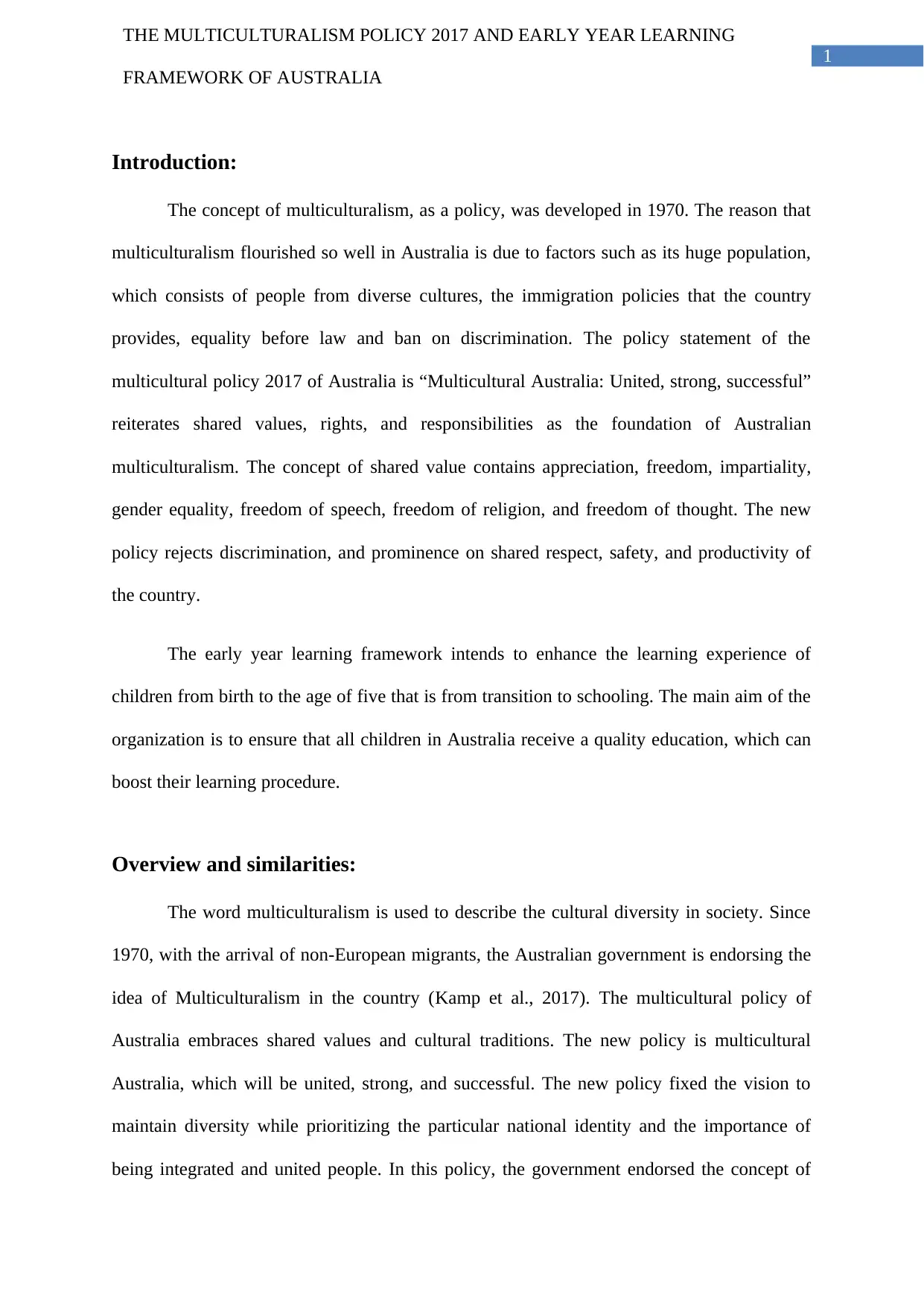
1
THE MULTICULTURALISM POLICY 2017 AND EARLY YEAR LEARNING
FRAMEWORK OF AUSTRALIA
Introduction:
The concept of multiculturalism, as a policy, was developed in 1970. The reason that
multiculturalism flourished so well in Australia is due to factors such as its huge population,
which consists of people from diverse cultures, the immigration policies that the country
provides, equality before law and ban on discrimination. The policy statement of the
multicultural policy 2017 of Australia is “Multicultural Australia: United, strong, successful”
reiterates shared values, rights, and responsibilities as the foundation of Australian
multiculturalism. The concept of shared value contains appreciation, freedom, impartiality,
gender equality, freedom of speech, freedom of religion, and freedom of thought. The new
policy rejects discrimination, and prominence on shared respect, safety, and productivity of
the country.
The early year learning framework intends to enhance the learning experience of
children from birth to the age of five that is from transition to schooling. The main aim of the
organization is to ensure that all children in Australia receive a quality education, which can
boost their learning procedure.
Overview and similarities:
The word multiculturalism is used to describe the cultural diversity in society. Since
1970, with the arrival of non-European migrants, the Australian government is endorsing the
idea of Multiculturalism in the country (Kamp et al., 2017). The multicultural policy of
Australia embraces shared values and cultural traditions. The new policy is multicultural
Australia, which will be united, strong, and successful. The new policy fixed the vision to
maintain diversity while prioritizing the particular national identity and the importance of
being integrated and united people. In this policy, the government endorsed the concept of
THE MULTICULTURALISM POLICY 2017 AND EARLY YEAR LEARNING
FRAMEWORK OF AUSTRALIA
Introduction:
The concept of multiculturalism, as a policy, was developed in 1970. The reason that
multiculturalism flourished so well in Australia is due to factors such as its huge population,
which consists of people from diverse cultures, the immigration policies that the country
provides, equality before law and ban on discrimination. The policy statement of the
multicultural policy 2017 of Australia is “Multicultural Australia: United, strong, successful”
reiterates shared values, rights, and responsibilities as the foundation of Australian
multiculturalism. The concept of shared value contains appreciation, freedom, impartiality,
gender equality, freedom of speech, freedom of religion, and freedom of thought. The new
policy rejects discrimination, and prominence on shared respect, safety, and productivity of
the country.
The early year learning framework intends to enhance the learning experience of
children from birth to the age of five that is from transition to schooling. The main aim of the
organization is to ensure that all children in Australia receive a quality education, which can
boost their learning procedure.
Overview and similarities:
The word multiculturalism is used to describe the cultural diversity in society. Since
1970, with the arrival of non-European migrants, the Australian government is endorsing the
idea of Multiculturalism in the country (Kamp et al., 2017). The multicultural policy of
Australia embraces shared values and cultural traditions. The new policy is multicultural
Australia, which will be united, strong, and successful. The new policy fixed the vision to
maintain diversity while prioritizing the particular national identity and the importance of
being integrated and united people. In this policy, the government endorsed the concept of
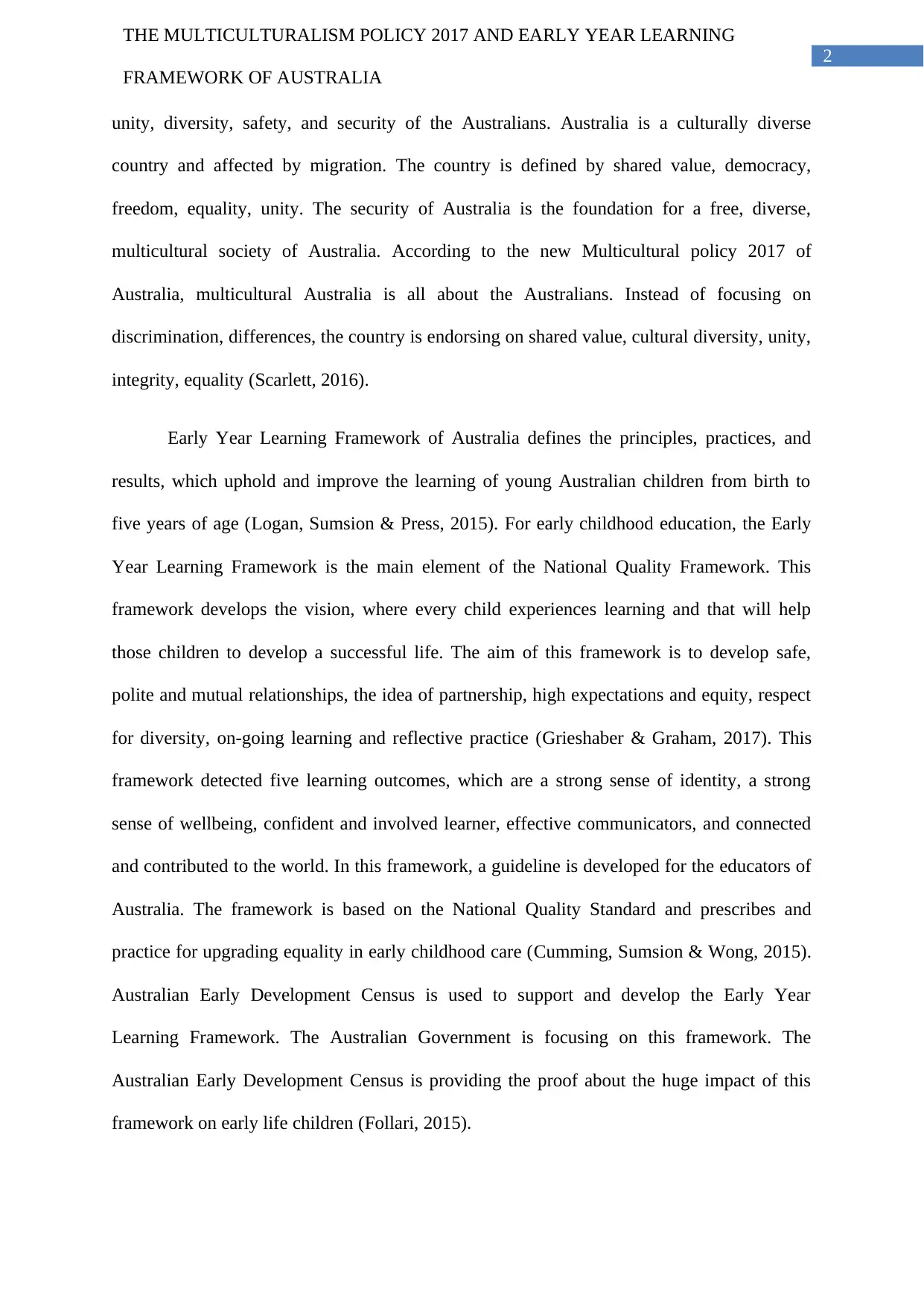
2
THE MULTICULTURALISM POLICY 2017 AND EARLY YEAR LEARNING
FRAMEWORK OF AUSTRALIA
unity, diversity, safety, and security of the Australians. Australia is a culturally diverse
country and affected by migration. The country is defined by shared value, democracy,
freedom, equality, unity. The security of Australia is the foundation for a free, diverse,
multicultural society of Australia. According to the new Multicultural policy 2017 of
Australia, multicultural Australia is all about the Australians. Instead of focusing on
discrimination, differences, the country is endorsing on shared value, cultural diversity, unity,
integrity, equality (Scarlett, 2016).
Early Year Learning Framework of Australia defines the principles, practices, and
results, which uphold and improve the learning of young Australian children from birth to
five years of age (Logan, Sumsion & Press, 2015). For early childhood education, the Early
Year Learning Framework is the main element of the National Quality Framework. This
framework develops the vision, where every child experiences learning and that will help
those children to develop a successful life. The aim of this framework is to develop safe,
polite and mutual relationships, the idea of partnership, high expectations and equity, respect
for diversity, on-going learning and reflective practice (Grieshaber & Graham, 2017). This
framework detected five learning outcomes, which are a strong sense of identity, a strong
sense of wellbeing, confident and involved learner, effective communicators, and connected
and contributed to the world. In this framework, a guideline is developed for the educators of
Australia. The framework is based on the National Quality Standard and prescribes and
practice for upgrading equality in early childhood care (Cumming, Sumsion & Wong, 2015).
Australian Early Development Census is used to support and develop the Early Year
Learning Framework. The Australian Government is focusing on this framework. The
Australian Early Development Census is providing the proof about the huge impact of this
framework on early life children (Follari, 2015).
THE MULTICULTURALISM POLICY 2017 AND EARLY YEAR LEARNING
FRAMEWORK OF AUSTRALIA
unity, diversity, safety, and security of the Australians. Australia is a culturally diverse
country and affected by migration. The country is defined by shared value, democracy,
freedom, equality, unity. The security of Australia is the foundation for a free, diverse,
multicultural society of Australia. According to the new Multicultural policy 2017 of
Australia, multicultural Australia is all about the Australians. Instead of focusing on
discrimination, differences, the country is endorsing on shared value, cultural diversity, unity,
integrity, equality (Scarlett, 2016).
Early Year Learning Framework of Australia defines the principles, practices, and
results, which uphold and improve the learning of young Australian children from birth to
five years of age (Logan, Sumsion & Press, 2015). For early childhood education, the Early
Year Learning Framework is the main element of the National Quality Framework. This
framework develops the vision, where every child experiences learning and that will help
those children to develop a successful life. The aim of this framework is to develop safe,
polite and mutual relationships, the idea of partnership, high expectations and equity, respect
for diversity, on-going learning and reflective practice (Grieshaber & Graham, 2017). This
framework detected five learning outcomes, which are a strong sense of identity, a strong
sense of wellbeing, confident and involved learner, effective communicators, and connected
and contributed to the world. In this framework, a guideline is developed for the educators of
Australia. The framework is based on the National Quality Standard and prescribes and
practice for upgrading equality in early childhood care (Cumming, Sumsion & Wong, 2015).
Australian Early Development Census is used to support and develop the Early Year
Learning Framework. The Australian Government is focusing on this framework. The
Australian Early Development Census is providing the proof about the huge impact of this
framework on early life children (Follari, 2015).
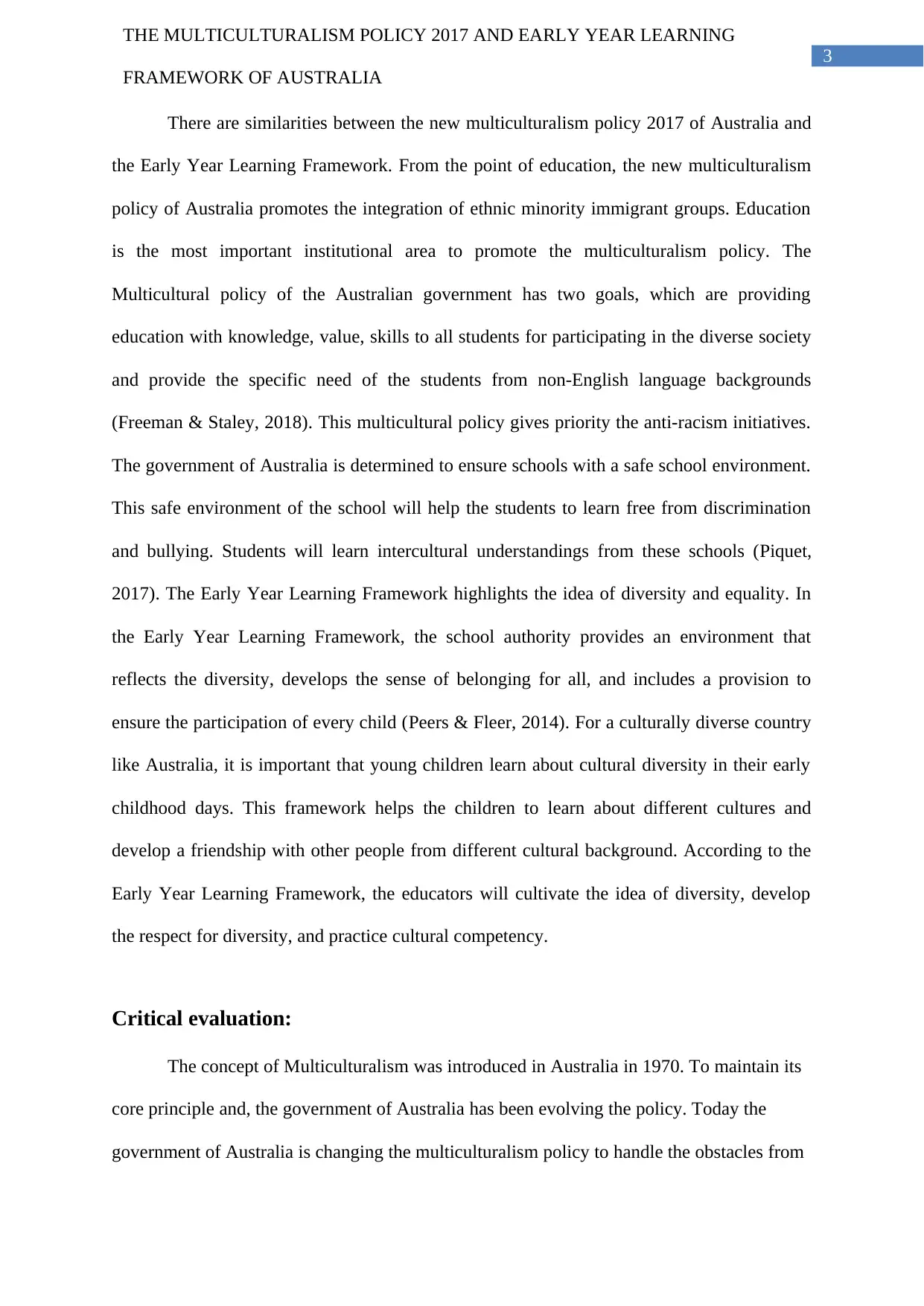
3
THE MULTICULTURALISM POLICY 2017 AND EARLY YEAR LEARNING
FRAMEWORK OF AUSTRALIA
There are similarities between the new multiculturalism policy 2017 of Australia and
the Early Year Learning Framework. From the point of education, the new multiculturalism
policy of Australia promotes the integration of ethnic minority immigrant groups. Education
is the most important institutional area to promote the multiculturalism policy. The
Multicultural policy of the Australian government has two goals, which are providing
education with knowledge, value, skills to all students for participating in the diverse society
and provide the specific need of the students from non-English language backgrounds
(Freeman & Staley, 2018). This multicultural policy gives priority the anti-racism initiatives.
The government of Australia is determined to ensure schools with a safe school environment.
This safe environment of the school will help the students to learn free from discrimination
and bullying. Students will learn intercultural understandings from these schools (Piquet,
2017). The Early Year Learning Framework highlights the idea of diversity and equality. In
the Early Year Learning Framework, the school authority provides an environment that
reflects the diversity, develops the sense of belonging for all, and includes a provision to
ensure the participation of every child (Peers & Fleer, 2014). For a culturally diverse country
like Australia, it is important that young children learn about cultural diversity in their early
childhood days. This framework helps the children to learn about different cultures and
develop a friendship with other people from different cultural background. According to the
Early Year Learning Framework, the educators will cultivate the idea of diversity, develop
the respect for diversity, and practice cultural competency.
Critical evaluation:
The concept of Multiculturalism was introduced in Australia in 1970. To maintain its
core principle and, the government of Australia has been evolving the policy. Today the
government of Australia is changing the multiculturalism policy to handle the obstacles from
THE MULTICULTURALISM POLICY 2017 AND EARLY YEAR LEARNING
FRAMEWORK OF AUSTRALIA
There are similarities between the new multiculturalism policy 2017 of Australia and
the Early Year Learning Framework. From the point of education, the new multiculturalism
policy of Australia promotes the integration of ethnic minority immigrant groups. Education
is the most important institutional area to promote the multiculturalism policy. The
Multicultural policy of the Australian government has two goals, which are providing
education with knowledge, value, skills to all students for participating in the diverse society
and provide the specific need of the students from non-English language backgrounds
(Freeman & Staley, 2018). This multicultural policy gives priority the anti-racism initiatives.
The government of Australia is determined to ensure schools with a safe school environment.
This safe environment of the school will help the students to learn free from discrimination
and bullying. Students will learn intercultural understandings from these schools (Piquet,
2017). The Early Year Learning Framework highlights the idea of diversity and equality. In
the Early Year Learning Framework, the school authority provides an environment that
reflects the diversity, develops the sense of belonging for all, and includes a provision to
ensure the participation of every child (Peers & Fleer, 2014). For a culturally diverse country
like Australia, it is important that young children learn about cultural diversity in their early
childhood days. This framework helps the children to learn about different cultures and
develop a friendship with other people from different cultural background. According to the
Early Year Learning Framework, the educators will cultivate the idea of diversity, develop
the respect for diversity, and practice cultural competency.
Critical evaluation:
The concept of Multiculturalism was introduced in Australia in 1970. To maintain its
core principle and, the government of Australia has been evolving the policy. Today the
government of Australia is changing the multiculturalism policy to handle the obstacles from
Secure Best Marks with AI Grader
Need help grading? Try our AI Grader for instant feedback on your assignments.
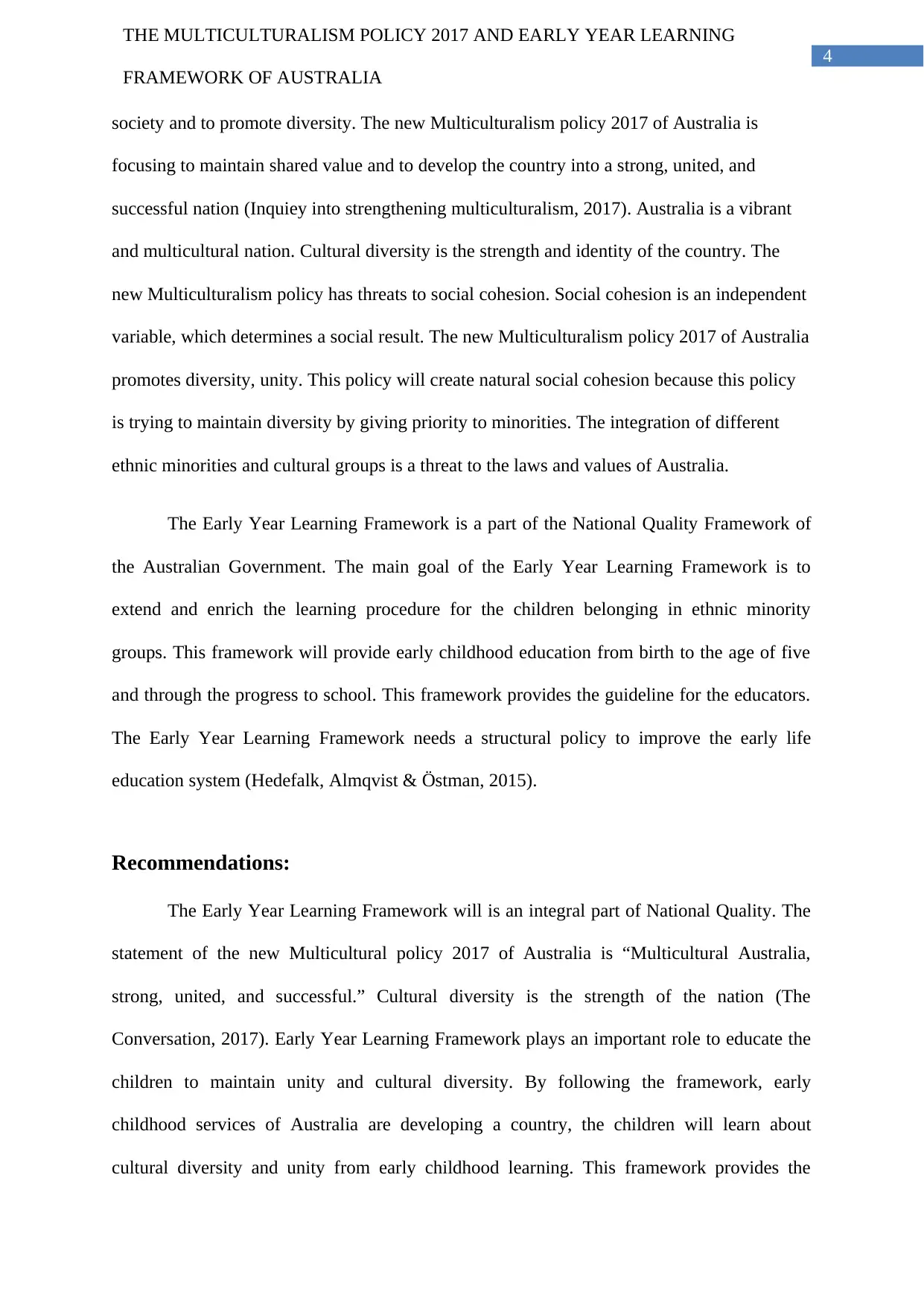
4
THE MULTICULTURALISM POLICY 2017 AND EARLY YEAR LEARNING
FRAMEWORK OF AUSTRALIA
society and to promote diversity. The new Multiculturalism policy 2017 of Australia is
focusing to maintain shared value and to develop the country into a strong, united, and
successful nation (Inquiey into strengthening multiculturalism, 2017). Australia is a vibrant
and multicultural nation. Cultural diversity is the strength and identity of the country. The
new Multiculturalism policy has threats to social cohesion. Social cohesion is an independent
variable, which determines a social result. The new Multiculturalism policy 2017 of Australia
promotes diversity, unity. This policy will create natural social cohesion because this policy
is trying to maintain diversity by giving priority to minorities. The integration of different
ethnic minorities and cultural groups is a threat to the laws and values of Australia.
The Early Year Learning Framework is a part of the National Quality Framework of
the Australian Government. The main goal of the Early Year Learning Framework is to
extend and enrich the learning procedure for the children belonging in ethnic minority
groups. This framework will provide early childhood education from birth to the age of five
and through the progress to school. This framework provides the guideline for the educators.
The Early Year Learning Framework needs a structural policy to improve the early life
education system (Hedefalk, Almqvist & Östman, 2015).
Recommendations:
The Early Year Learning Framework will is an integral part of National Quality. The
statement of the new Multicultural policy 2017 of Australia is “Multicultural Australia,
strong, united, and successful.” Cultural diversity is the strength of the nation (The
Conversation, 2017). Early Year Learning Framework plays an important role to educate the
children to maintain unity and cultural diversity. By following the framework, early
childhood services of Australia are developing a country, the children will learn about
cultural diversity and unity from early childhood learning. This framework provides the
THE MULTICULTURALISM POLICY 2017 AND EARLY YEAR LEARNING
FRAMEWORK OF AUSTRALIA
society and to promote diversity. The new Multiculturalism policy 2017 of Australia is
focusing to maintain shared value and to develop the country into a strong, united, and
successful nation (Inquiey into strengthening multiculturalism, 2017). Australia is a vibrant
and multicultural nation. Cultural diversity is the strength and identity of the country. The
new Multiculturalism policy has threats to social cohesion. Social cohesion is an independent
variable, which determines a social result. The new Multiculturalism policy 2017 of Australia
promotes diversity, unity. This policy will create natural social cohesion because this policy
is trying to maintain diversity by giving priority to minorities. The integration of different
ethnic minorities and cultural groups is a threat to the laws and values of Australia.
The Early Year Learning Framework is a part of the National Quality Framework of
the Australian Government. The main goal of the Early Year Learning Framework is to
extend and enrich the learning procedure for the children belonging in ethnic minority
groups. This framework will provide early childhood education from birth to the age of five
and through the progress to school. This framework provides the guideline for the educators.
The Early Year Learning Framework needs a structural policy to improve the early life
education system (Hedefalk, Almqvist & Östman, 2015).
Recommendations:
The Early Year Learning Framework will is an integral part of National Quality. The
statement of the new Multicultural policy 2017 of Australia is “Multicultural Australia,
strong, united, and successful.” Cultural diversity is the strength of the nation (The
Conversation, 2017). Early Year Learning Framework plays an important role to educate the
children to maintain unity and cultural diversity. By following the framework, early
childhood services of Australia are developing a country, the children will learn about
cultural diversity and unity from early childhood learning. This framework provides the
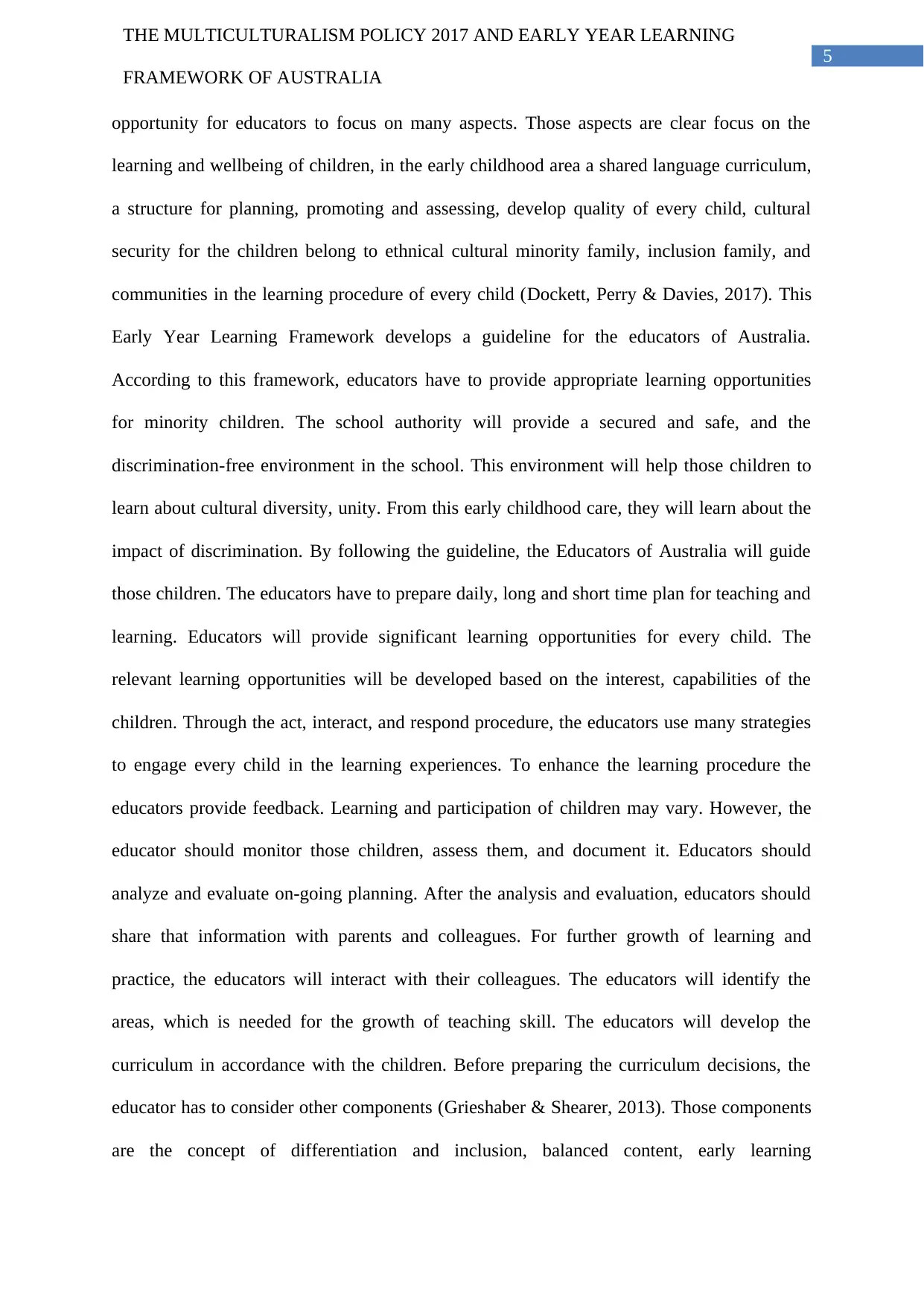
5
THE MULTICULTURALISM POLICY 2017 AND EARLY YEAR LEARNING
FRAMEWORK OF AUSTRALIA
opportunity for educators to focus on many aspects. Those aspects are clear focus on the
learning and wellbeing of children, in the early childhood area a shared language curriculum,
a structure for planning, promoting and assessing, develop quality of every child, cultural
security for the children belong to ethnical cultural minority family, inclusion family, and
communities in the learning procedure of every child (Dockett, Perry & Davies, 2017). This
Early Year Learning Framework develops a guideline for the educators of Australia.
According to this framework, educators have to provide appropriate learning opportunities
for minority children. The school authority will provide a secured and safe, and the
discrimination-free environment in the school. This environment will help those children to
learn about cultural diversity, unity. From this early childhood care, they will learn about the
impact of discrimination. By following the guideline, the Educators of Australia will guide
those children. The educators have to prepare daily, long and short time plan for teaching and
learning. Educators will provide significant learning opportunities for every child. The
relevant learning opportunities will be developed based on the interest, capabilities of the
children. Through the act, interact, and respond procedure, the educators use many strategies
to engage every child in the learning experiences. To enhance the learning procedure the
educators provide feedback. Learning and participation of children may vary. However, the
educator should monitor those children, assess them, and document it. Educators should
analyze and evaluate on-going planning. After the analysis and evaluation, educators should
share that information with parents and colleagues. For further growth of learning and
practice, the educators will interact with their colleagues. The educators will identify the
areas, which is needed for the growth of teaching skill. The educators will develop the
curriculum in accordance with the children. Before preparing the curriculum decisions, the
educator has to consider other components (Grieshaber & Shearer, 2013). Those components
are the concept of differentiation and inclusion, balanced content, early learning
THE MULTICULTURALISM POLICY 2017 AND EARLY YEAR LEARNING
FRAMEWORK OF AUSTRALIA
opportunity for educators to focus on many aspects. Those aspects are clear focus on the
learning and wellbeing of children, in the early childhood area a shared language curriculum,
a structure for planning, promoting and assessing, develop quality of every child, cultural
security for the children belong to ethnical cultural minority family, inclusion family, and
communities in the learning procedure of every child (Dockett, Perry & Davies, 2017). This
Early Year Learning Framework develops a guideline for the educators of Australia.
According to this framework, educators have to provide appropriate learning opportunities
for minority children. The school authority will provide a secured and safe, and the
discrimination-free environment in the school. This environment will help those children to
learn about cultural diversity, unity. From this early childhood care, they will learn about the
impact of discrimination. By following the guideline, the Educators of Australia will guide
those children. The educators have to prepare daily, long and short time plan for teaching and
learning. Educators will provide significant learning opportunities for every child. The
relevant learning opportunities will be developed based on the interest, capabilities of the
children. Through the act, interact, and respond procedure, the educators use many strategies
to engage every child in the learning experiences. To enhance the learning procedure the
educators provide feedback. Learning and participation of children may vary. However, the
educator should monitor those children, assess them, and document it. Educators should
analyze and evaluate on-going planning. After the analysis and evaluation, educators should
share that information with parents and colleagues. For further growth of learning and
practice, the educators will interact with their colleagues. The educators will identify the
areas, which is needed for the growth of teaching skill. The educators will develop the
curriculum in accordance with the children. Before preparing the curriculum decisions, the
educator has to consider other components (Grieshaber & Shearer, 2013). Those components
are the concept of differentiation and inclusion, balanced content, early learning
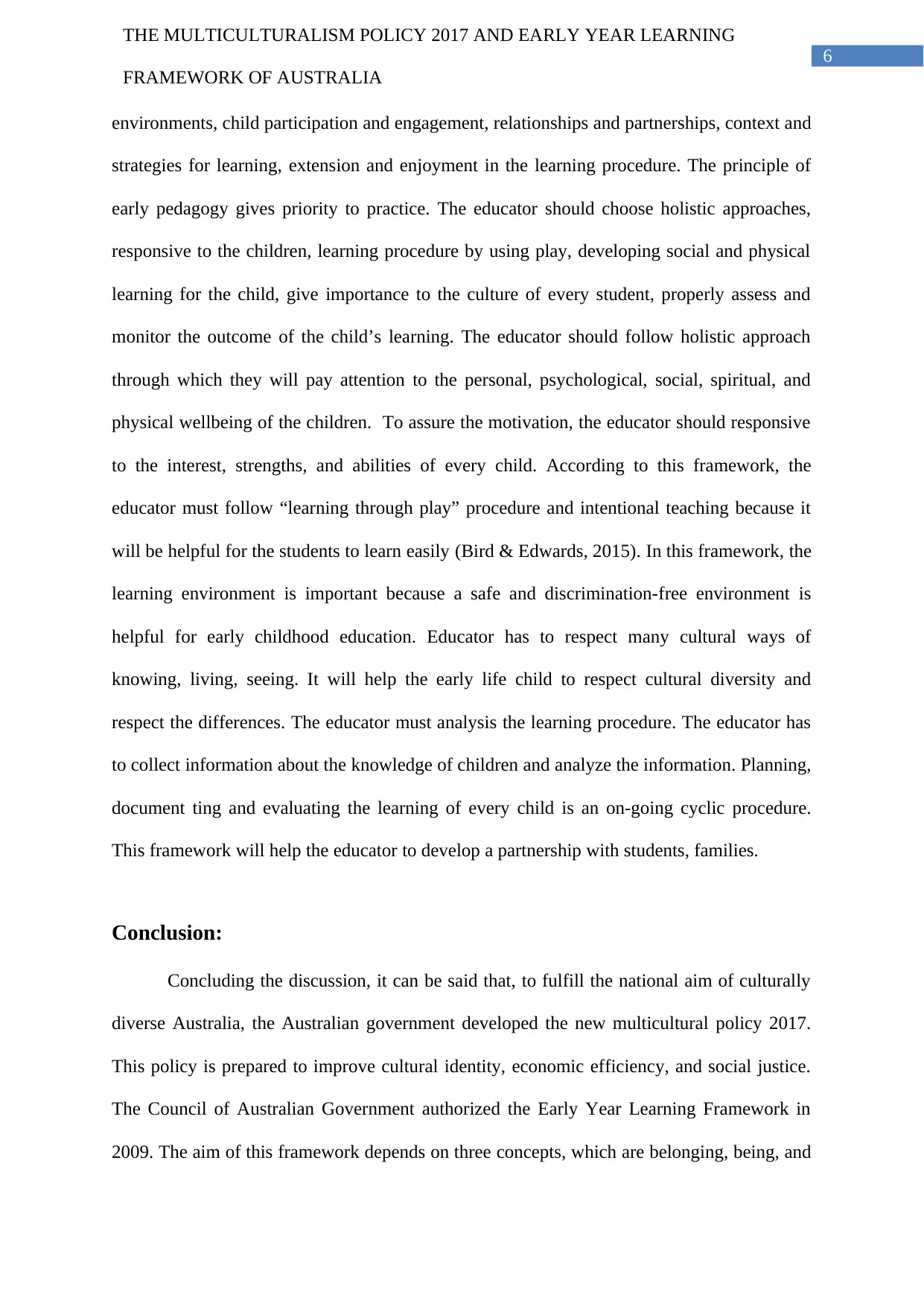
6
THE MULTICULTURALISM POLICY 2017 AND EARLY YEAR LEARNING
FRAMEWORK OF AUSTRALIA
environments, child participation and engagement, relationships and partnerships, context and
strategies for learning, extension and enjoyment in the learning procedure. The principle of
early pedagogy gives priority to practice. The educator should choose holistic approaches,
responsive to the children, learning procedure by using play, developing social and physical
learning for the child, give importance to the culture of every student, properly assess and
monitor the outcome of the child’s learning. The educator should follow holistic approach
through which they will pay attention to the personal, psychological, social, spiritual, and
physical wellbeing of the children. To assure the motivation, the educator should responsive
to the interest, strengths, and abilities of every child. According to this framework, the
educator must follow “learning through play” procedure and intentional teaching because it
will be helpful for the students to learn easily (Bird & Edwards, 2015). In this framework, the
learning environment is important because a safe and discrimination-free environment is
helpful for early childhood education. Educator has to respect many cultural ways of
knowing, living, seeing. It will help the early life child to respect cultural diversity and
respect the differences. The educator must analysis the learning procedure. The educator has
to collect information about the knowledge of children and analyze the information. Planning,
document ting and evaluating the learning of every child is an on-going cyclic procedure.
This framework will help the educator to develop a partnership with students, families.
Conclusion:
Concluding the discussion, it can be said that, to fulfill the national aim of culturally
diverse Australia, the Australian government developed the new multicultural policy 2017.
This policy is prepared to improve cultural identity, economic efficiency, and social justice.
The Council of Australian Government authorized the Early Year Learning Framework in
2009. The aim of this framework depends on three concepts, which are belonging, being, and
THE MULTICULTURALISM POLICY 2017 AND EARLY YEAR LEARNING
FRAMEWORK OF AUSTRALIA
environments, child participation and engagement, relationships and partnerships, context and
strategies for learning, extension and enjoyment in the learning procedure. The principle of
early pedagogy gives priority to practice. The educator should choose holistic approaches,
responsive to the children, learning procedure by using play, developing social and physical
learning for the child, give importance to the culture of every student, properly assess and
monitor the outcome of the child’s learning. The educator should follow holistic approach
through which they will pay attention to the personal, psychological, social, spiritual, and
physical wellbeing of the children. To assure the motivation, the educator should responsive
to the interest, strengths, and abilities of every child. According to this framework, the
educator must follow “learning through play” procedure and intentional teaching because it
will be helpful for the students to learn easily (Bird & Edwards, 2015). In this framework, the
learning environment is important because a safe and discrimination-free environment is
helpful for early childhood education. Educator has to respect many cultural ways of
knowing, living, seeing. It will help the early life child to respect cultural diversity and
respect the differences. The educator must analysis the learning procedure. The educator has
to collect information about the knowledge of children and analyze the information. Planning,
document ting and evaluating the learning of every child is an on-going cyclic procedure.
This framework will help the educator to develop a partnership with students, families.
Conclusion:
Concluding the discussion, it can be said that, to fulfill the national aim of culturally
diverse Australia, the Australian government developed the new multicultural policy 2017.
This policy is prepared to improve cultural identity, economic efficiency, and social justice.
The Council of Australian Government authorized the Early Year Learning Framework in
2009. The aim of this framework depends on three concepts, which are belonging, being, and
Paraphrase This Document
Need a fresh take? Get an instant paraphrase of this document with our AI Paraphraser
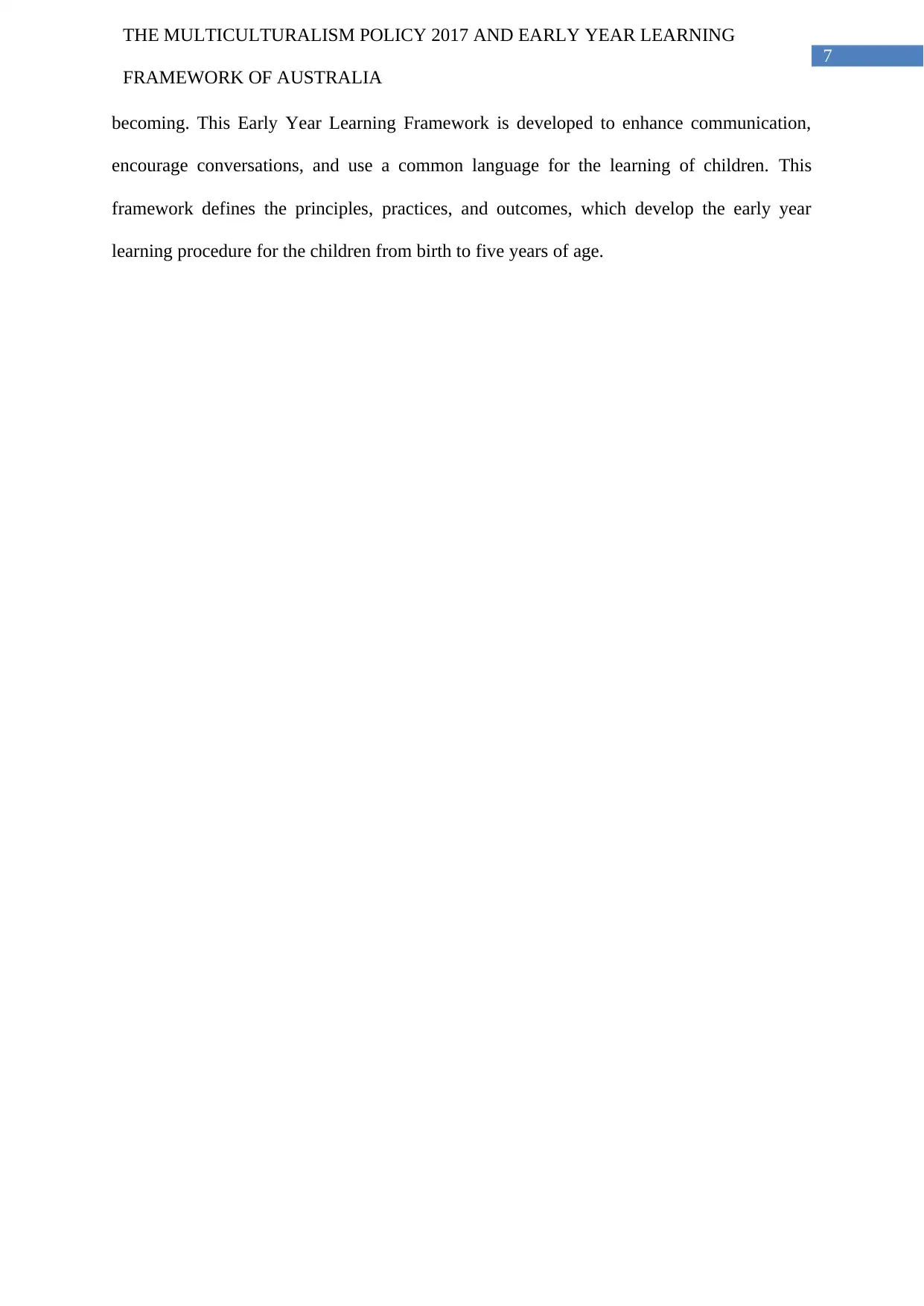
7
THE MULTICULTURALISM POLICY 2017 AND EARLY YEAR LEARNING
FRAMEWORK OF AUSTRALIA
becoming. This Early Year Learning Framework is developed to enhance communication,
encourage conversations, and use a common language for the learning of children. This
framework defines the principles, practices, and outcomes, which develop the early year
learning procedure for the children from birth to five years of age.
THE MULTICULTURALISM POLICY 2017 AND EARLY YEAR LEARNING
FRAMEWORK OF AUSTRALIA
becoming. This Early Year Learning Framework is developed to enhance communication,
encourage conversations, and use a common language for the learning of children. This
framework defines the principles, practices, and outcomes, which develop the early year
learning procedure for the children from birth to five years of age.
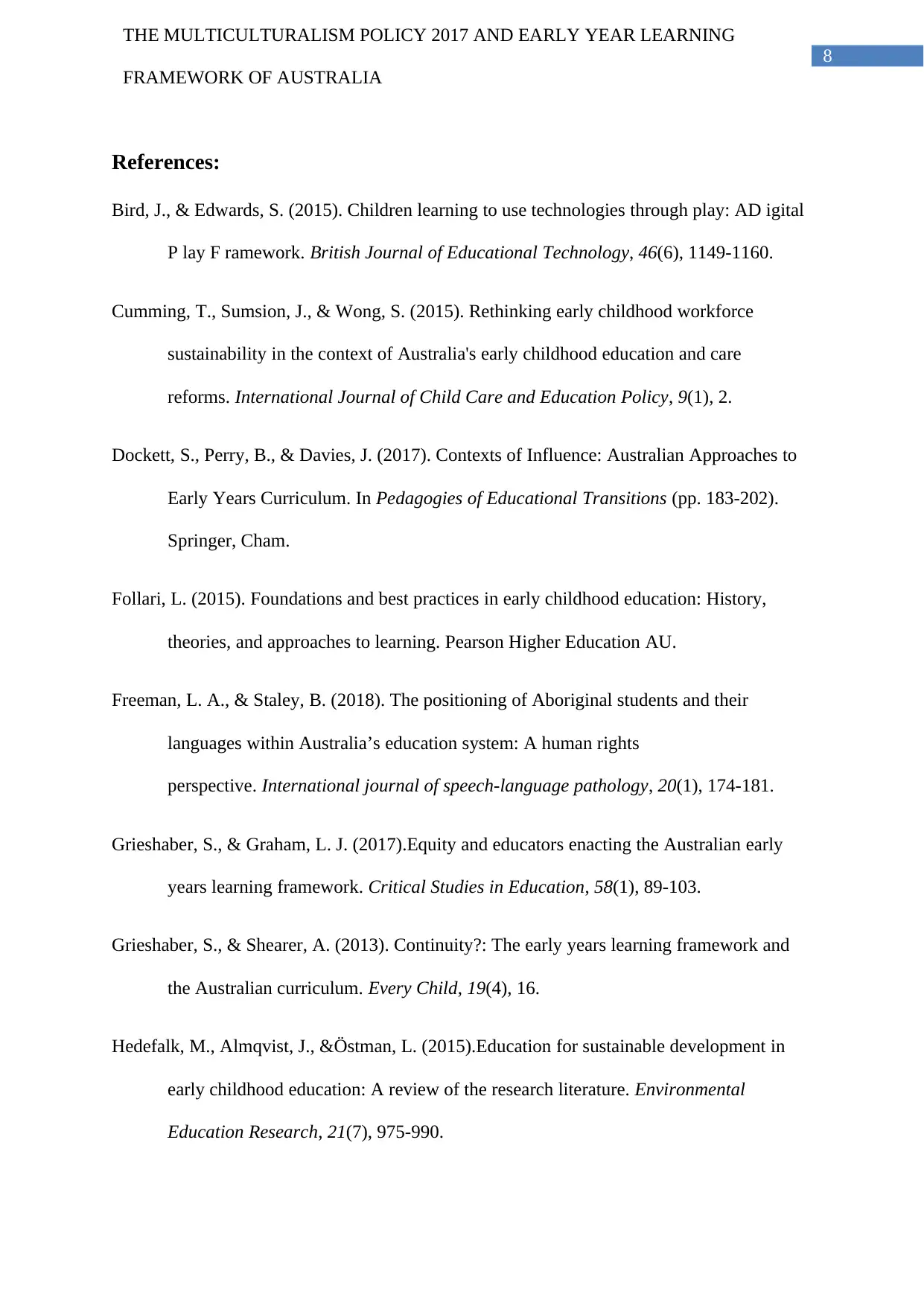
8
THE MULTICULTURALISM POLICY 2017 AND EARLY YEAR LEARNING
FRAMEWORK OF AUSTRALIA
References:
Bird, J., & Edwards, S. (2015). Children learning to use technologies through play: AD igital
P lay F ramework. British Journal of Educational Technology, 46(6), 1149-1160.
Cumming, T., Sumsion, J., & Wong, S. (2015). Rethinking early childhood workforce
sustainability in the context of Australia's early childhood education and care
reforms. International Journal of Child Care and Education Policy, 9(1), 2.
Dockett, S., Perry, B., & Davies, J. (2017). Contexts of Influence: Australian Approaches to
Early Years Curriculum. In Pedagogies of Educational Transitions (pp. 183-202).
Springer, Cham.
Follari, L. (2015). Foundations and best practices in early childhood education: History,
theories, and approaches to learning. Pearson Higher Education AU.
Freeman, L. A., & Staley, B. (2018). The positioning of Aboriginal students and their
languages within Australia’s education system: A human rights
perspective. International journal of speech-language pathology, 20(1), 174-181.
Grieshaber, S., & Graham, L. J. (2017).Equity and educators enacting the Australian early
years learning framework. Critical Studies in Education, 58(1), 89-103.
Grieshaber, S., & Shearer, A. (2013). Continuity?: The early years learning framework and
the Australian curriculum. Every Child, 19(4), 16.
Hedefalk, M., Almqvist, J., &Östman, L. (2015).Education for sustainable development in
early childhood education: A review of the research literature. Environmental
Education Research, 21(7), 975-990.
THE MULTICULTURALISM POLICY 2017 AND EARLY YEAR LEARNING
FRAMEWORK OF AUSTRALIA
References:
Bird, J., & Edwards, S. (2015). Children learning to use technologies through play: AD igital
P lay F ramework. British Journal of Educational Technology, 46(6), 1149-1160.
Cumming, T., Sumsion, J., & Wong, S. (2015). Rethinking early childhood workforce
sustainability in the context of Australia's early childhood education and care
reforms. International Journal of Child Care and Education Policy, 9(1), 2.
Dockett, S., Perry, B., & Davies, J. (2017). Contexts of Influence: Australian Approaches to
Early Years Curriculum. In Pedagogies of Educational Transitions (pp. 183-202).
Springer, Cham.
Follari, L. (2015). Foundations and best practices in early childhood education: History,
theories, and approaches to learning. Pearson Higher Education AU.
Freeman, L. A., & Staley, B. (2018). The positioning of Aboriginal students and their
languages within Australia’s education system: A human rights
perspective. International journal of speech-language pathology, 20(1), 174-181.
Grieshaber, S., & Graham, L. J. (2017).Equity and educators enacting the Australian early
years learning framework. Critical Studies in Education, 58(1), 89-103.
Grieshaber, S., & Shearer, A. (2013). Continuity?: The early years learning framework and
the Australian curriculum. Every Child, 19(4), 16.
Hedefalk, M., Almqvist, J., &Östman, L. (2015).Education for sustainable development in
early childhood education: A review of the research literature. Environmental
Education Research, 21(7), 975-990.
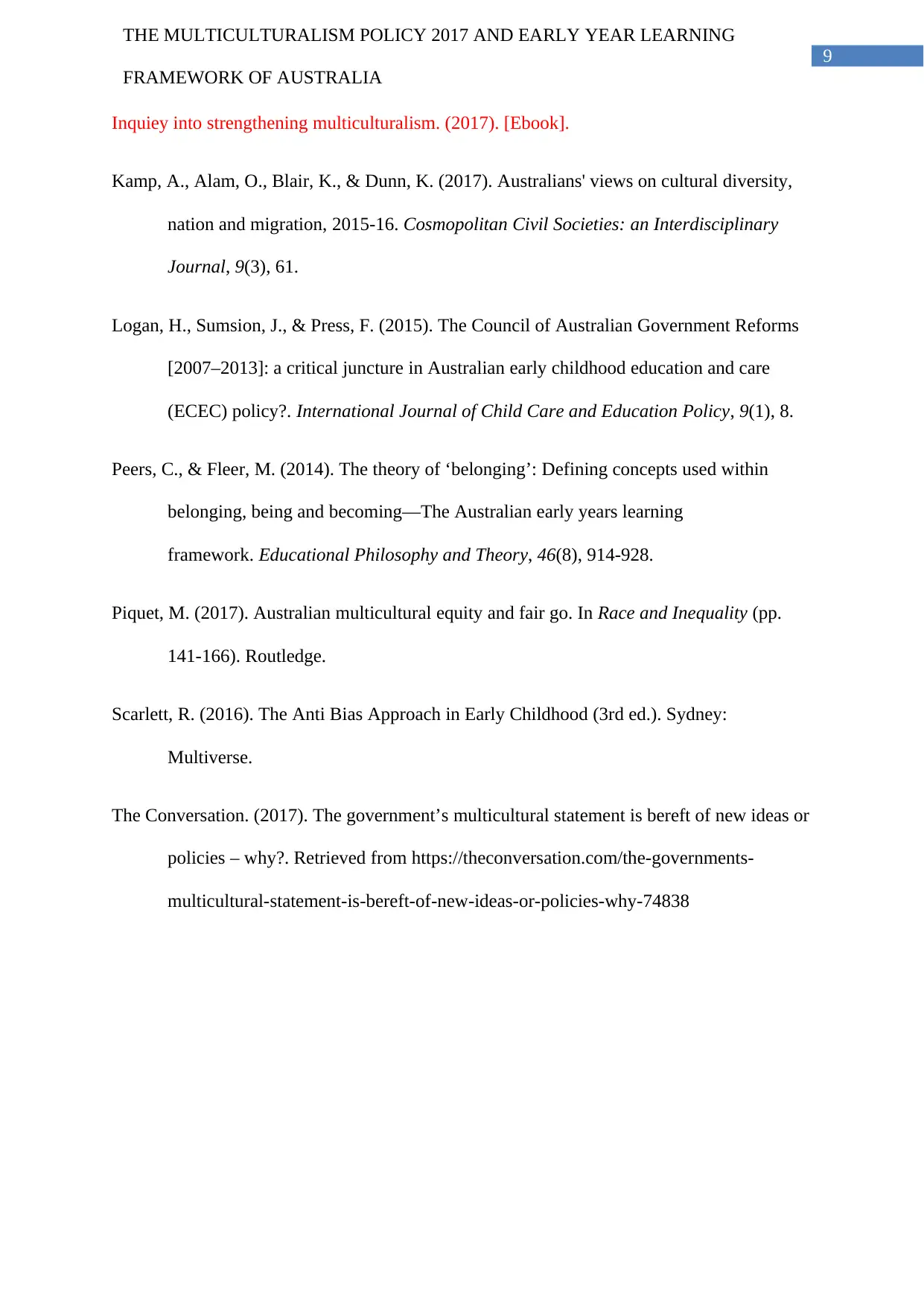
9
THE MULTICULTURALISM POLICY 2017 AND EARLY YEAR LEARNING
FRAMEWORK OF AUSTRALIA
Inquiey into strengthening multiculturalism. (2017). [Ebook].
Kamp, A., Alam, O., Blair, K., & Dunn, K. (2017). Australians' views on cultural diversity,
nation and migration, 2015-16. Cosmopolitan Civil Societies: an Interdisciplinary
Journal, 9(3), 61.
Logan, H., Sumsion, J., & Press, F. (2015). The Council of Australian Government Reforms
[2007–2013]: a critical juncture in Australian early childhood education and care
(ECEC) policy?. International Journal of Child Care and Education Policy, 9(1), 8.
Peers, C., & Fleer, M. (2014). The theory of ‘belonging’: Defining concepts used within
belonging, being and becoming—The Australian early years learning
framework. Educational Philosophy and Theory, 46(8), 914-928.
Piquet, M. (2017). Australian multicultural equity and fair go. In Race and Inequality (pp.
141-166). Routledge.
Scarlett, R. (2016). The Anti Bias Approach in Early Childhood (3rd ed.). Sydney:
Multiverse.
The Conversation. (2017). The government’s multicultural statement is bereft of new ideas or
policies – why?. Retrieved from https://theconversation.com/the-governments-
multicultural-statement-is-bereft-of-new-ideas-or-policies-why-74838
THE MULTICULTURALISM POLICY 2017 AND EARLY YEAR LEARNING
FRAMEWORK OF AUSTRALIA
Inquiey into strengthening multiculturalism. (2017). [Ebook].
Kamp, A., Alam, O., Blair, K., & Dunn, K. (2017). Australians' views on cultural diversity,
nation and migration, 2015-16. Cosmopolitan Civil Societies: an Interdisciplinary
Journal, 9(3), 61.
Logan, H., Sumsion, J., & Press, F. (2015). The Council of Australian Government Reforms
[2007–2013]: a critical juncture in Australian early childhood education and care
(ECEC) policy?. International Journal of Child Care and Education Policy, 9(1), 8.
Peers, C., & Fleer, M. (2014). The theory of ‘belonging’: Defining concepts used within
belonging, being and becoming—The Australian early years learning
framework. Educational Philosophy and Theory, 46(8), 914-928.
Piquet, M. (2017). Australian multicultural equity and fair go. In Race and Inequality (pp.
141-166). Routledge.
Scarlett, R. (2016). The Anti Bias Approach in Early Childhood (3rd ed.). Sydney:
Multiverse.
The Conversation. (2017). The government’s multicultural statement is bereft of new ideas or
policies – why?. Retrieved from https://theconversation.com/the-governments-
multicultural-statement-is-bereft-of-new-ideas-or-policies-why-74838
1 out of 10
Related Documents
Your All-in-One AI-Powered Toolkit for Academic Success.
+13062052269
info@desklib.com
Available 24*7 on WhatsApp / Email
![[object Object]](/_next/static/media/star-bottom.7253800d.svg)
Unlock your academic potential
© 2024 | Zucol Services PVT LTD | All rights reserved.





